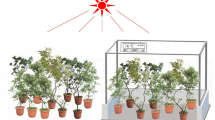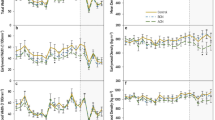Abstract
We compared autumn decomposition rates of European alder leaves at four sites along the Lasset–Hers River system, southern France, to test whether changes in litter decomposition rates from upstream (1,300 m elevation) to downstream (690 m) could be attributed to temperature-driven differences in microbial growth, shredder activity, or composition of the shredder community. Alder leaves lost 75–87% of original mass in 57 days, of which 46–67% could be attributed to microbial metabolism and 8–29% to shredder activity, with no trend along the river. Mass loss rates in both fine-mesh (excluding shredders) and coarse-mesh (including shredders) bags were faster at warm, downstream sites (mean daily temperature 7–8°C) than upstream (mean 1–2°C), but the difference disappeared when rates were expressed in heat units to remove the temperature effect. Mycelial biomass did not correlate with mass loss rates. Faster mass loss rates upstream, after temperature correction, evidently arise from more efficient shredding by Nemourid stoneflies than by the Leuctra-dominated assemblage downstream. The influence of water temperature on decomposition rate is therefore expressed both directly, through microbial metabolism, and indirectly, through the structure of shredder communities. These influences are evident even in cold water where temperature variation is small.







Similar content being viewed by others
References
Assmann, C., K. Rinke, J. Nechwatal & J. von Elert, 2011. Consequences of the colonisation of leaves by fungi and oomycetes for leaf consumption by a gammarid shredder. Freshwater Biology 56: 839–852.
Baldy, V., M. O. Gessner & E. Chauvet, 1995. Bacteria, fungi and the breakdown of leaf litter in a large river. Oikos 74: 93–102.
Bärlocher, F., 1985. The role of fungi in the nutrition of stream invertebrates. Botanical Journal of the Linnean Society 91: 85–94.
Benfield, E. F., R. W. Paul Jr. & J. R. Webster, 1979. Influence of exposure technique on leaf breakdown rates in streams. Oikos 33: 386–391.
Bergfur, J., 2007. Seasonal variation in leaf-litter breakdown in nine boreal streams: implications for assessing functional integrity. Fundamental and Applied Limnology 169: 319–330.
Boyero, L., R. G. Pearson, M. O. Gessner, L. A. Barmuta, V. Ferreira, M. A. S. Graça, D. Dudgeon, A. J. Boulton, M. Callisto, E. Chauvet, et al., 2011. A global experiment suggests climate warming will not accelerate litter decomposition in streams but might reduce carbon sequestration. Ecology Letters 14: 289–294.
Chauvet, E., N. Giani & M. O. Gessner, 1993. Breakdown and invertebrate colonization of leaf litter in two contrasting streams: significance of Oligochaetes in a large river. Canadian Journal of Fisheries and Aquatic Science 50: 488–495.
Chergui, H. & E. Pattee, 1993. Fungal and invertebrate colonization of Salix fresh and dry leaves in a Moroccan river system. Archiv für Hydrobiologie 127: 57–72.
Chung, N. & K. Suberkropp, 2009. Effects of aquatic fungi on feeding preferences and bioenergetics of Pycnopsyche gentilis (Trichoptera: Limnephilidae). Hydrobiologia 630: 257–269.
Collier, K. J. & M. J. Winterbourn, 1986. Processing of willow leaves in two suburban streams in Christchurch, New Zealand. New Zealand Journal of Marine and Freshwater Research 20: 575–582.
Dangles, O. & F. Guérold, 2001a. Influence of shredders in mediating breakdown rates of beech leaves in circumneutral and acidic forest streams. Archiv für Hydrobiologie 151: 649–666.
Dangles, O. & F. Guérold, 2001b. Linking shredders and leaf litter processing: insights from an acidic stream study. International Review of Hydrobiology 86: 395–406.
Elliott, J. M., 1987. Temperature-induced changes in the life cycle of Leuctra nigra (Plecoptera: Leuctridae) from a Lake District stream. Freshwater Biology 18: 177–184.
Fabre, E. & E. Chauvet, 1998. Leaf breakdown along an altitudinal stream gradient. Archiv für Hydrobiologie 141: 167–179.
Ferreira, V. & E. Chauvet, 2011a. Synergistic effects of water temperature and dissolved nutrients on litter decomposition and associated fungi. Global Change Biology 17: 551–564.
Ferreira, V. & E. Chauvet, 2011b. Future increase in temperature more than decrease in litter quality can affect microbial litter decomposition in streams. Oecologia 167: 279–291.
Fernandes, I., B. Uzun, C. Pascoal & F. Cássio, 2009. Responses of aquatic fungal communities on leaf litter to temperature-change events. International Review of Hydrobiology 94: 410–418.
Gessner, M. O. & E. Chauvet, 1993. Ergosterol-to-biomass conversion factors for aquatic hyphomycetes. Applied and Environmental Microbiology 59: 502–507.
Gessner, M. O., M. Dobson & E. Chauvet, 1999. A perspective on leaf litter breakdown in streams. Oikos 85: 377–384.
Giller, P. S. & B. Malmqvist, 1998. The Biology of Streams and Rivers. Oxford University Press, Oxford, UK: 296 pp.
Graça, M. A. S., 2001. The role of invertebrates on leaf litter decomposition in streams: a review. International Review of Hydrobiology 86: 383–394.
Graça, M. A. S., R. C. F. Ferreira & C. N. Coimbra, 2001. Processing along a stream gradient: the role of invertebrates and decomposers. Journal of the North American Benthological Society 20: 408–420.
Graça, M. A. S., F. Bärlocher M. & O. Gessner, 2005. Methods to Study Litter Decomposition: A Practical Guide. Springer, the Netherlands.
Hieber, M. M. & O. Gessner, 2002. Contribution of stream detrivores, fungi, and bacteria to leaf breakdown based on biomass estimates. Ecology 83: 1026–1038.
Imberger, S. J., C. J. Walsh & M. R. Grace, 2008. More microbial activity, not abrasive flow or shredder abundance, accelerates breakdown of labile leaf litter in urban streams. Journal of the North American Benthological Society 27: 549–561.
Irons, J. G., M. W. Oswood, R. J. Stout & C. M. Pringle, 1994. Latitudinal patterns in leaf litter breakdown – is temperature really important. Freshwater Biology 32: 401–411.
MacDonald, E. E. & B. R. Taylor, 2008. Factors influencing litter decomposition rates in upstream and downstream reaches of river systems in eastern Canada. Fundamental and Applied Limnology 172: 71–86.
Minshall, G. W., R. C. Petersen, K. W. Cummins, T. L. Bott, J. R. Sedell, C. E. Cushing & R. L. Vannote, 1983. Interbiome comparison of stream ecosystem dynamics. Ecological Monographs 53: 1–25.
Minshall, G. W., K. W. Cummins, R. C. Petersen, C. E. Cushing, D. A. Bruns, J. R. Sedell & R. L. Vannote, 1985. Developments in stream ecosystem theory. Canadian Journal of Fisheries and Aquatic Sciences 42: 1045–1055.
Petersen, R. C. & K. W. Cummins, 1974. Leaf processing in a woodland stream. Freshwater Biology 4: 343–368.
Prenda, J. & A. Gallardo-Mayenco, 1999. Distribution patterns, species assemblages and habitat selection of the stoneflies (Plecoptera) from two Mediterranean river basins in southern Spain. International Review of Hydrobiology 84: 595–608.
Rajashekar, M. & K. M. Kaveriappa, 2000. Effects of temperature and light on growth and sporulation of aquatic hyphomycetes. Hydrobiologia 441: 149–153.
Ramchunder, S. J., L. E. Brown, J. Holden & R. Langton, 2011. Spatial and seasonal variability of peatland stream ecosystems. Ecohydrology 4: 577–588.
Stockley, R. A., G. S. Oxford & R. F. G. Ormond, 1998. Do invertebrates matter? Detrital processing in the River Swale-Ouse. Science of the Total Environment 210(211): 427–435.
Suberkropp, K. & E. Chauvet, 1995. Regulation of leaf breakdown by fungi in streams: influences of water chemistry. Ecology 76: 1433–1445.
Suberkropp, K., M. O. Gessner & E. Chauvet, 1993. Comparison of ATP and ergosterol as indicators of fungal biomass associated with decomposing leaves in streams. Applied and Environmental Microbiology 59: 3367–3372.
Tachet, H., P. Richoux, M. Bournaud & P. Usseglio-Polatera, 2006. Invertébrés d’eau douce: systématique, biologie, écologie. CNRS Editions, Paris, France: 587 pp.
Tank, J. L., E. J. Rosi-Marshall, N. A. Griffiths, S. A. Entrekin & M. L. Stephen, 2010. A review of allochthonous organic matter dynamics and metabolism in streams. Journal of the North American Benthological Society 29: 118–146.
Taylor, B. R & I. V. Andrushchenko, 2013. Interaction of water temperature and shredders on leaf litter breakdown: a comparison of streams in Canada and Norway. Hydrobiologia. doi:10.1007/s10750-013-1650-2.
Taylor, B. R. & A. N. Dykstra, 2005. Effects of hot ground water on a small swamp-stream in Nova Scotia, Canada. Hydrobiologia 545: 129–144.
Walters, K. R., T. Sformo, B. M. Barnes & J. G. Duman, 2009. Freeze tolerance in an arctic Alaska stonefly. The Journal of Experimental Biology 212: 305–312.
Webster, J. R. & E. F. Benfeld, 1986. Vascular plant breakdown in freshwater ecosystems. Annual Review of Ecology and Systematics 17: 567–594.
Wiggins, G. B. & R. J. Mackay, 1978. Some relationships between systematics and trophic ecology in Nearctic aquatic insects, with special reference to Trichoptera. Ecology 59: 1211–1220.
Woodward, G., M. O. Gessner, P. S. Giller, V. Gulis, S. Hladz, A. Lecerf, B. Malmqvist, B. McKie, S. D. Tiegs, H. Cariss, et al., 2012. Continental-scale effects of nutrient pollution on stream ecosystem functioning. Science 336: 1438–1440.
Zar, J. H., 2010. Biostatistical Analysis, 5th ed. Pearson Prentice Hall, Upper Saddle River, NJ.
Acknowledgments
The authors are grateful to Didier Lambrigot and Sylvain Lamothe for their technical help in field and laboratory, and to Amanda Lowe and Greg Walsh for help in enumerating invertebrates. This manuscript also benefitted from constructive comments by two anonymous reviewers.
Author information
Authors and Affiliations
Corresponding author
Additional information
Handling editor: Sonja Stendera
Rights and permissions
About this article
Cite this article
Taylor, B.R., Chauvet, E.E. Relative influence of shredders and fungi on leaf litter decomposition along a river altitudinal gradient. Hydrobiologia 721, 239–250 (2014). https://doi.org/10.1007/s10750-013-1666-7
Received:
Revised:
Accepted:
Published:
Issue Date:
DOI: https://doi.org/10.1007/s10750-013-1666-7




